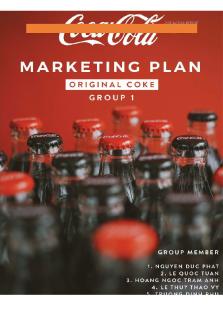Case 4 - Cola Wars - Case Study PDF

| Title | Case 4 - Cola Wars - Case Study |
|---|---|
| Author | Siddhant Agarwal |
| Course | Strategic Mgt |
| Institution | University of Georgia |
| Pages | 2 |
| File Size | 70.4 KB |
| File Type | |
| Total Downloads | 34 |
| Total Views | 137 |
Summary
Case Study...
Description
SIDDHANT AGARWAL – UGA ID 811751760 “Cola Wars” o Why historically, has the soft drink industry been so profitable? The soft drink industry has been so profitable historically because both the US and the worldwide consumption of soft drinks rose steadily year after year. The competition to prove itself better than the other improved Coke and Pepsi’s product quality. The CSD consumption grew by an average of 3% per year over next 3 decades from 1970s, i.e. 23 gallons per average American per year to 53 gallons per average American per year. The declining prices and introduction of flavoured & diet varieties fuelled the sales and in turn profits. The companies started various options to choose from and the sales started to boost but the dominant segment was still that of cola. o Compare the concentrate business to that of the bottling business: Why is the profitability so different? Concentrate producer blended raw material ingredients, packed the mixture and shipped that to bottler. Concentrate makers often added artificial sweetener for diet CSDs. Bottlers usually added sugar or highfructose corn syrup for regular CSDs themselves. The concentrate manufacturing process required relatively little capital investment in machinery, overhead, or labor. A concentrate producer’s most significant costs were for advertising, promotion, market research, and bottler support. Concentrate makers negotiated “Customer Development Agreements (CDA)” while bottlers handled with business with smaller regional accounts. The bottling business was capital-intensive and involved high-speed production lines. The cost of large plant with multiple lines and automated warehousing could reach hundreds of millions of dollars. Bottlers also invested in trucks and distributions networks which feasted upon the large part of their profits as operational costs. Because of the huge operational costs of bottlers, the profitability was so different for both businesses. o How has the competition between Coke and Pepsi affected the industry’s profits? The competition became fierce between Pepsi and Coke when Pepsi started growing its business and built a network of 270 bottlers and lowered the price of its 12-oz bottle to a nickel, the same price that that Coke charged for a 6.5-oz bottle. Coke later filed a suit against Pepsi, claiming that Pepsi-Cola brand was an infringement on the Coca-Cola trademark. The ruling came out in Pepsi’s favour. Pepsi started price cutting to compete with Coke to sell more in the market and later when tried to match the prices with Coke, received opposition to the decision. Therefore, Pepsi promised to use that money
on promotions and advertising. Both Coke and Pepsi started to experiment new flavors to launch into market by either acquisitions or introducing new brands. o How can Coke and Pepsi sustain their profits in the wake of flattening demand and the growing popularity of non-CSDs? Coke and Pepsi can sustain their profits by marketing their non-CSDs and snacks into the market. These 2 companies already have products such as Minute Maid and Frito-Lay, all they need to do is promotion and advertising. All their sugary drinks could be switched to stevia-based to attract new customers who are health conscious and have been avoiding CSDs for the sole purpose of health. Moreover, the company should play on their already existing plan of promoting products internationally and assessing their big market in India and China among others. Promoting non-CSDs such as juices could bring the companies back in the game and help sustain their profits....
Similar Free PDFs

Case 4 - Cola Wars - Case Study
- 2 Pages

Grocery Wars Case Study
- 3 Pages

COCA-COLA CASE STUDY
- 13 Pages

Coca cola case study
- 2 Pages

COCA COLA CASE Study
- 5 Pages

Coca Cola Company Case Study
- 4 Pages

Case Study - Assignment 4
- 5 Pages

Case Study 4 biochemistry
- 9 Pages

Assignment 4 - case study
- 5 Pages

Case Study 4 assignment
- 4 Pages

Assignment 4 case study
- 3 Pages

Cola War - Case notes
- 2 Pages

CASE Study Analyis ON Pepsi COLA
- 8 Pages

Cola Wars dossier
- 9 Pages
Popular Institutions
- Tinajero National High School - Annex
- Politeknik Caltex Riau
- Yokohama City University
- SGT University
- University of Al-Qadisiyah
- Divine Word College of Vigan
- Techniek College Rotterdam
- Universidade de Santiago
- Universiti Teknologi MARA Cawangan Johor Kampus Pasir Gudang
- Poltekkes Kemenkes Yogyakarta
- Baguio City National High School
- Colegio san marcos
- preparatoria uno
- Centro de Bachillerato Tecnológico Industrial y de Servicios No. 107
- Dalian Maritime University
- Quang Trung Secondary School
- Colegio Tecnológico en Informática
- Corporación Regional de Educación Superior
- Grupo CEDVA
- Dar Al Uloom University
- Centro de Estudios Preuniversitarios de la Universidad Nacional de Ingeniería
- 上智大学
- Aakash International School, Nuna Majara
- San Felipe Neri Catholic School
- Kang Chiao International School - New Taipei City
- Misamis Occidental National High School
- Institución Educativa Escuela Normal Juan Ladrilleros
- Kolehiyo ng Pantukan
- Batanes State College
- Instituto Continental
- Sekolah Menengah Kejuruan Kesehatan Kaltara (Tarakan)
- Colegio de La Inmaculada Concepcion - Cebu

